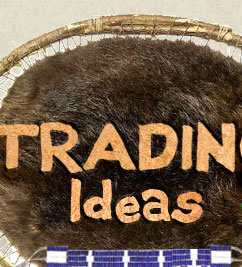Trade Activity
Standard version of the activity
| Image | Title | Transcription | Description |
|---|---|---|---|
| n/a | Introduction | Please read the instructions, rules and mission to understand the activity and how the game is played. | n/a |
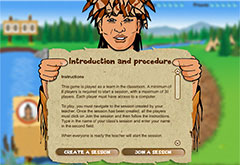 |
Instructions, rules and mission |
InstructionsThis game is played as a team in the classroom. A minimum of 6 players (including the creator of the session) is required to start a session, with a maximum of 30 players. Each player must have access to a computer. In the classroomTo play, you must navigate to the session created by your teacher. Once the session has been created, all the players must click on Join a session and then follow the instructions. Type in the name of your class’s session and enter your name in the second field. Outside the classroomOne player creates the session by clicking on Create a session. The other players are told the name chosen for the session so that they can log in to play. Players log in to the session by clicking on Join a session and entering the name of the session and then their name in the second field. RulesThis activity consists of trading your item for that of another player. MissionYour mission is to find the item that you need and trade your item for it. Playing the gameDuring the game you will have access at all times to your profile, your list of friends and the instructions. At the top of the game window, you will see coloured circles representing the number of friends that you have and the number of questions that you have answered correctly. When you make a friend or give a correct answer, one of the circles changes colour. Remember that you must make 5 friends and give 5 correct answers in order to complete the session. |
Picture of the Wendat chief with the instructions in his hands. There are buttons marked CREATE A SESSION and JOIN A SESSION at the bottom of the text box. |
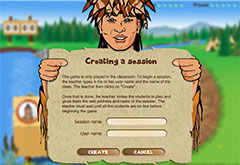 |
Create session | The game is only played in the classroom. To begin a session, the teacher types in his or her user name and the name of the class. The teacher then clicks on CREATE. Once that is done, the teacher invites the students to play and gives them the web address and name of the session. The teacher must wait until all the students are on-line before beginning the game. |
Picture of the Wendat chief with the instructions for creating a session in his hands. Below the instructions, there are two text boxes for entering Session name and User name. There are also buttons marked CREATE and CANCEL. |
 |
Join session | Your teacher has registered your class to play Trading Ideas. Wait a few moments until everyone is ready. Your teacher will start the session. | Picture of the Wendat chief with the instructions for creating a session in his hands. Below the instructions, there are two text boxes for entering Session name and User name. There are also buttons marked JOIN and CANCEL. |
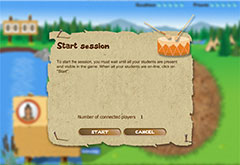 |
Start a session | To start the session, you must wait until all your students are present and visible in the game. When all your students are online, click on Start. | Window for starting the session when all the students are online and registered. There are buttons marked START and CANCEL. |
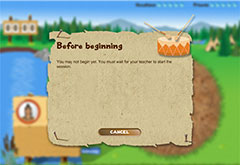 |
Before beginning | You cannot begin yet. You must wait for your teacher to start the session. | Window indicating that the session has not started yet. There is a button marked CANCEL. |
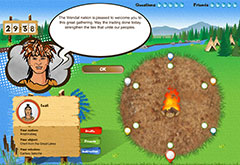 |
Message from the chief at the beginning of the session | The Wendat confederation is pleased to welcome you to this great gathering. May the trading done today strengthen the ties that unite our peoples. | Shown against the main background of the game, the Wendat chief welcomes the participants. |
 |
Main page | This page is the main page of the game. On this page, you will find: The game area The counter showing the remaining time Your profile Your list of friends The instructions The number of friends that you have The number of correct answers that you have given |
Main page of the game. There is a river, a forest, a counter showing the time left in the game, a fire and a panel with your profile (nation or confederation, item, mission), your friends and the instructions. A brown circle around the fire represents the area where the game is played. Inside the circle are icons representing the other players and the items that they have for trade. |
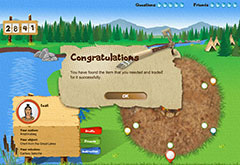 |
Confirm trade | Are you sure you want to trade your item for: X? | Window that tells you to make a trade. There are buttons marked ACCEPT and REFUSE. |
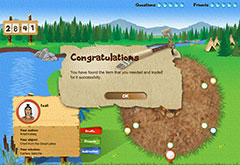 |
Confirm (Yes) | You have accepted the trade and your item has been traded. | n/a |
 |
Confirm (No) | You must accept the trade because it is the item that you need. | n/a |
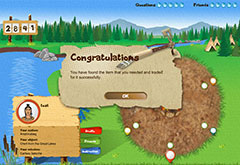 |
Main page when the trade has been made successfully | You have found the item that you needed and traded for it successfully. | Window congratulating you on your successful trade. There is a button marked OK. |
 |
Main page when the trade has not been made successfully | This is not the item that you are looking for. Keep searching. | Window indicating that the trade has not been made successfully. There is a button marked OK. |
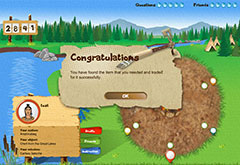 |
Main page when you have given the correct answer | Bravo! That is the right answer. | Window congratulating you for giving the correct answer to a question. |
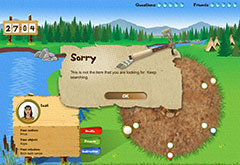 |
Main page when you have given a wrong answer | Sorry, that is not the right answer. | Window indicating that you have not given the correct answer to a question. There is a button marked OK. |
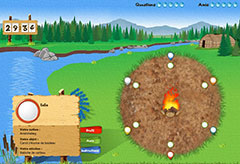 |
Main page: Profile | You can click on the Profile icon to see information about your character. It shows the name of your nation or confederation, the item that you possess and the item that you are looking for. | n/a |
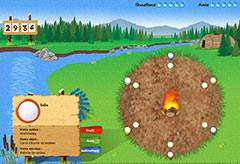 |
Main page: Friends | During the game you must make friends from the other nations and confederations. When you meet someone who does not belong to your nation or confederation, you can add them to your list of friends in order to collect enough friends to finish the game. This page shows you who has been added to your list of friends. | n/a |
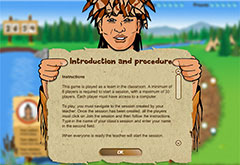 |
Main page: Instructions | You will find the same instructions, rules and mission given at the beginning of the game. | Picture of the Wendat chief with the instructions in his hands. |
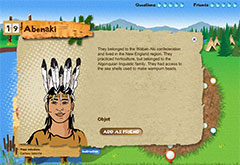 |
The nations and confederations | The game contains information on 6 nations and confederations. Throughout the game you will discover information about your nation or confederation and those of your friends. | n/a |
 |
Anishinabeg | The Algonquin and Ojibway called themselves Anishinabeg. They were semi-nomadic nations living in western Quebec and northern Ontario. They traded with the Iroquoian nations mainly to obtain dried vegetables and tobacco. | Window showing the Anishinabeg chief with a short description. There is also the item that you have for trade. When you are in the information sheet for your own nation or confederation, there are no buttons for TRADE or ADD. |
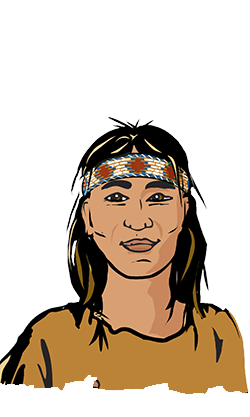 |
Innu | Semi-nomadic, the Innu travelled between the north shore of the Saint Lawrence River and the interior. Like most hunter-gatherer nations, they traded their surplus meat, hides and pelts. | Window showing the Innu chief with a short description. There is also the item he has for trade. When you are in the information sheet for another nation or confederation, there is a button marked ADD that lets you add this player to your list of friends and another marked TRADE if you wish to trade their item for yours. |
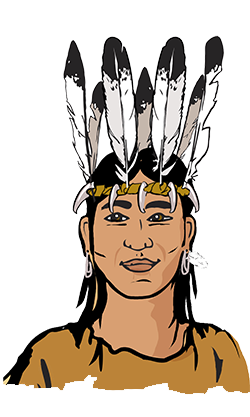 |
Abenaki | They belonged to the Waban-Aki confederation and lived in the New England region. They practiced horticulture, but belonged to the Algonquian linguistic family. They had access to the sea shells used to make wampum beads. | Window showing the Abenaki chief with a short description. There is also the item he has for trade. When you are in the information sheet for another nation or confederation, there is a button marked ADD that lets you add this player to your list of friends and another marked TRADE if you wish to trade their item for yours. |
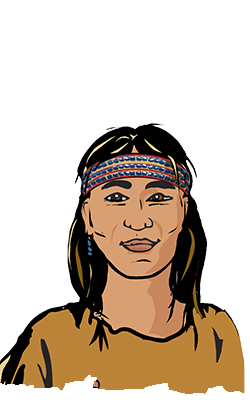 |
Mi’kmaw | They fished the seas of the Maritimes and the Gaspé peninsula in their birch bark canoes. Semi-nomadic, they traded seal skins and sea shells with other nations. | Window showing the Mi’kmaw chief with a short description. There is also the item he has for trade. When you are in the information sheet for another nation or confederation, there is a button marked ADD that lets you add this player to your list of friends and another marked TRADE if you wish to trade their item for yours. |
 |
Haudenosaunee | This was an Iroquois confederation, settled south of the Great Lakes. These nations cultivated the Three Sisters and traded their surplus crops. | Window showing the Haudenosaunee chief with a short description. There is also the item he has for trade. When you are in the information sheet for another nation or confederation, there is a button marked ADD that lets you add this player to your list of friends and another marked TRADE if you wish to trade their item for yours. |
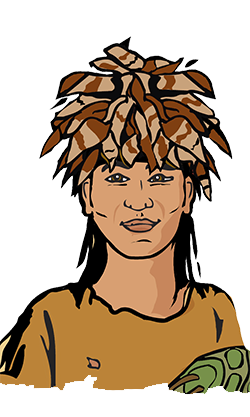 |
Wendat | This was a confederation composed of nations living along the Great Lakes and the Saint Lawrence Valley. They cultivated the Three Sisters. The Wendat played an important role as intermediaries with the nations west of the Great Lakes, and their language was used by several other nations for commerce. | Window showing the Wendat chief with a short description. There is also the item he has for trade. When you are in the information sheet for another nation or confederation, there is a button marked ADD that lets you add this player to your list of friends and another marked TRADE if you wish to trade their item for yours. |
 |
Trade items and questions | The game contains 30 trade items and throughout the game you have access to the information sheets on these items. | Window with the trade item. There is also a question about one of the trade items. This question is not necessarily about the item shown in the panel. There are buttons marked "TRUE" and "FALSE" for answering the question. |
 |
Caribou babiche | Rawhide strips called babiche were used for snowshoe webbing and to bind the structural elements of a dwelling. Caribou babiche was the most sought after for snowshoes because thinner strips could be used to make a tighter weave. | Picture of snowshoes |
 |
Birch bark canoe | It was ideal for travelling in North America. The size and shape depended on what the canoe is going to be used for. | Picture of a bark canoe |
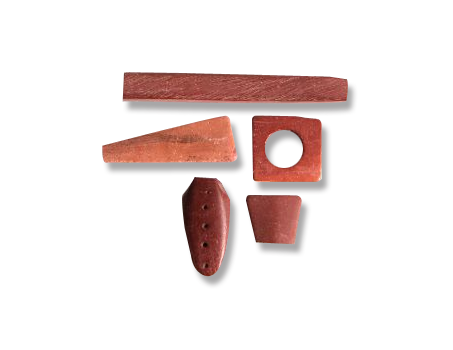 |
Catlinite | This stone is only found in Wisconsin and Minnesota. It was used to make sacred pipes and jewellery. | Picture showing various items made from catlinite |
 |
Chert from the Great Lakes | Chert is an extremely hard type of rock that can be broken to form very sharp edges. It was used to make tools, knives and projectile points. | Picture showing various items made from chert from the Great Lakes |
 |
Sea shells | They could be used to make jewellery, in particular pendants. | Picture of an item of jewellery made from sea shells |
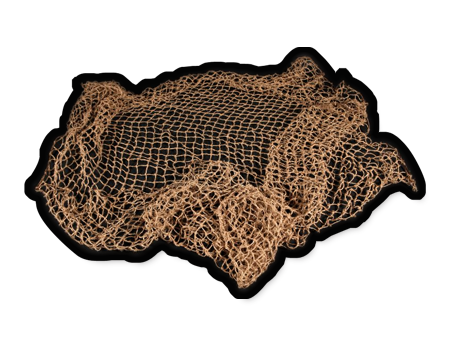 |
Rope | Made from vegetable fibres, it was used for nets and bowstrings. | Picture of a net |
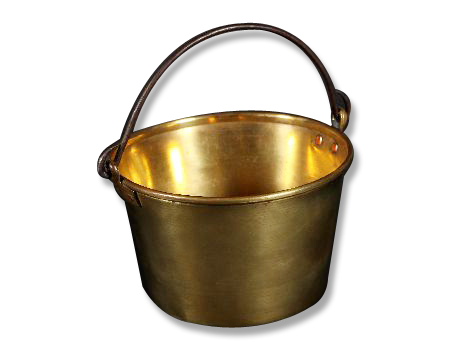 |
Native copper | It could be hammered to make knives and jewellery. It was usually used to make items of prestige because of its colour. | Picture of a knife with a copper blade |
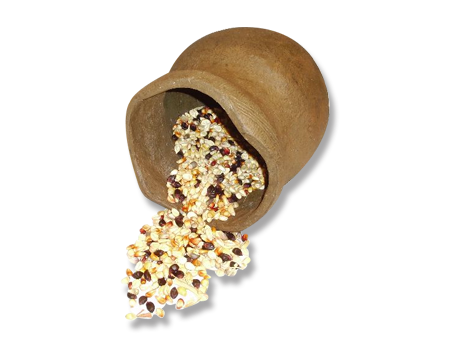 |
Corn flour | It had various uses in cooking, notably for making bread. | Picture of corn |
 |
Dried beans | One of the Three Sisters grown by the Iroquoians, beans were dried to preserve them. | Picture of dried beans |
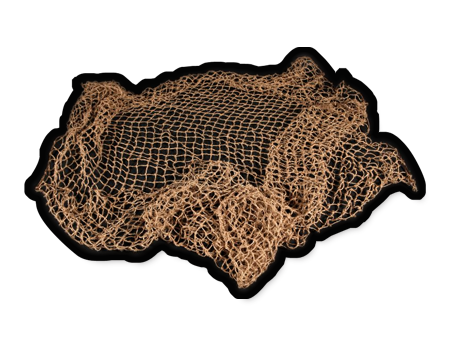 |
Fishing nets | Made from vegetable fibre rope, a net made it easy to catch several fish at a time. | Picture of a net |
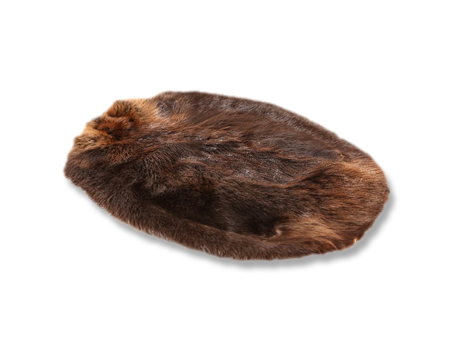 |
Beaver pelt | Beaver fur retains heat and keeps the wearer warm. It was used to make winter clothing. | Picture of a beaver pelt |
 |
Black squirrel fur | Owning a coat made from black squirrel fur was a symbol of prosperity for some Iroquoian nations. They traded with the Algonquians to obtain them. | Picture of several black squirrel pelts |
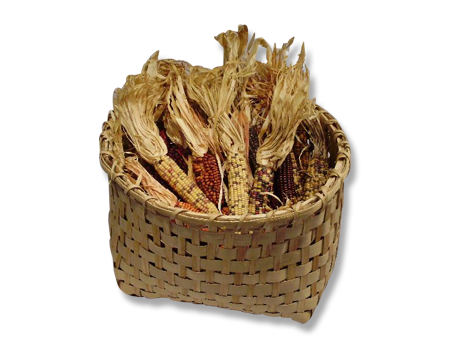 |
Dried corn | Corn was one of the Three Sisters grown by the Iroquoians. It was dried to preserve it. | Picture of dried corn |
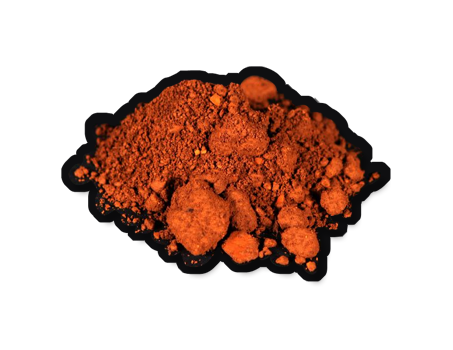 |
Ochre | Mixed with animal fat, this coloured earth pigment was used to make ceremonial face paint. | Picture of ochre |
 |
Birch bark basket | Light and easy to make, it was used for transporting and storing goods. | Picture of a birch bark basket |
 |
Ash bark basket | This woven basket is light but strong. It was used for transporting and storing goods. | Picture of an ash bark basket |
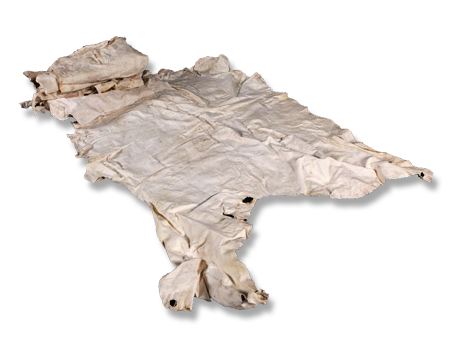 |
Caribou hide | It was mainly used to make clothing. | Picture of a caribou hide |
 |
Deer hide | It was mainly used to make clothing. | Picture of a boot made from deer hide |
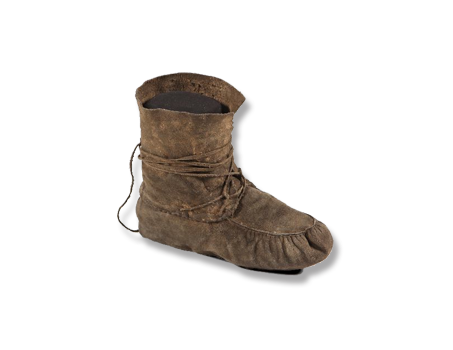 |
Seal skins | They were mainly used to make mocassins and winter clothing. | Picture of a seal skin |
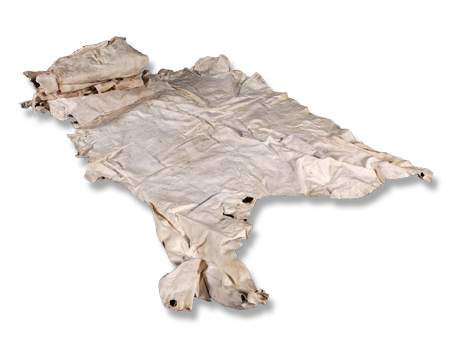 |
Moose hide | It was mainly used to make clothing. | Picture of a moose hide |
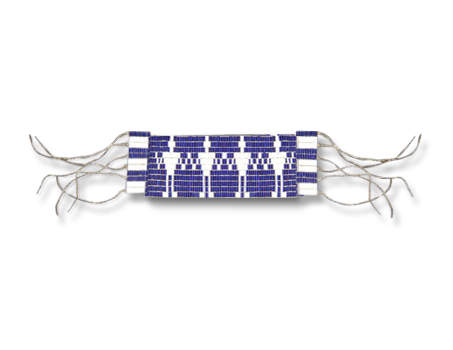 |
Wampum beads | Made on the east coast of North America, these beads had great value because they were used to make wampum belts. | Picture of wampum beads |
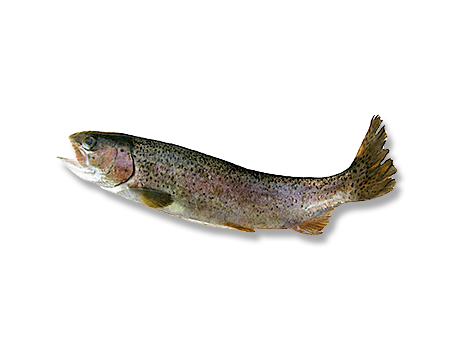 |
Smoked fish | Fish that has been smoke-dried to preserve it. | Picture of a fish |
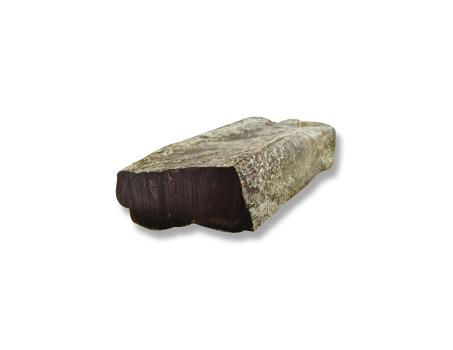 |
Dried meat | Meat that has been dried to preserve it. | Picture of strips of dried meat |
 |
Mistassini quartzite | This stone was used to make tools and was traded over long distances. | Picture of quartzite |
 |
Ramah quartzite | This stone was used to make tools and was traded over long distances. | Picture of quartzite |
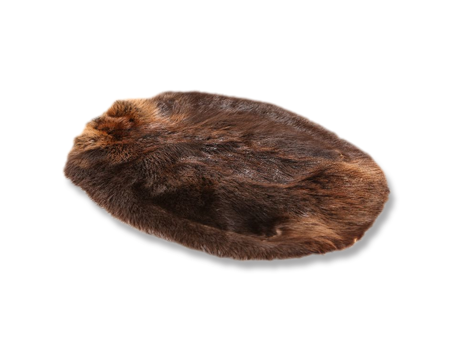 |
Beaver robe | Winter clothing from beaver pelts. | Picture of a beaver pelt |
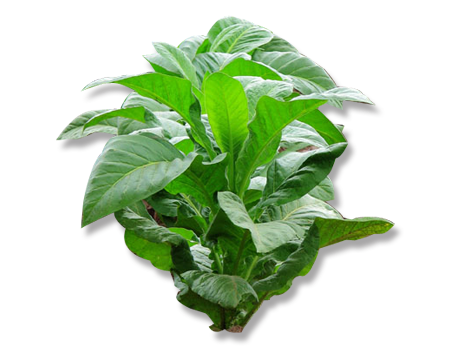 |
Tobacco | This plant was only grown by certain nations, notably the Petun. It was one of the sacred plants and had great value at trade gatherings. | Picture of a tobacco plant |
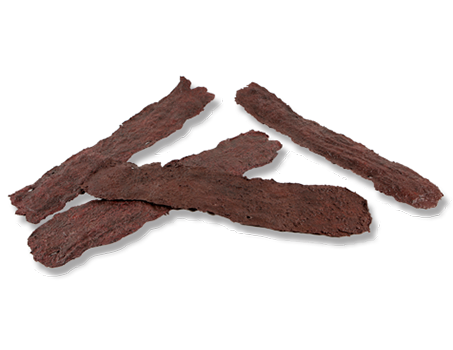 |
Smoked caribou meat | Caribou meat that has been smoke-dried to preserve it. | Picture of dried meat |
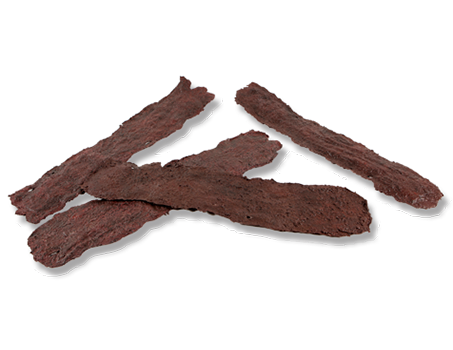 |
Smoked deer meat | Deer meat that has been smoke-dried to preserve it. | Picture of strips of dried meat |
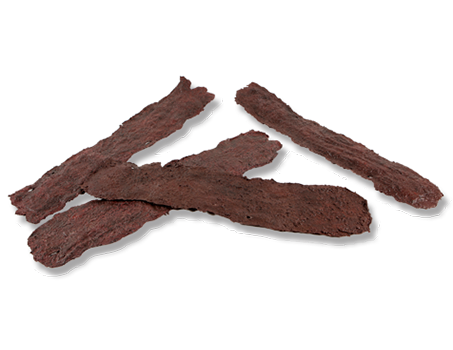 |
Smoked moose meat | Moose meat that has been smoke-dried to preserve it. | Picture of strips of dried meat |
| n/a | Question 1 | Caribou babiche was used to make snowshoes and hats. Answer: False |
n/a |
| n/a | Question 2 | Birch bark canoes were all the same size and shape. Answer: False |
n/a |
| n/a | Question 3 | Catlinite was used to make sacred pipes and jewellery. Answer: True |
n/a |
| n/a | Question 4 | Chert is a plant that grows in the Far North. Answer: False |
n/a |
| n/a | Question 5 | Sea shells were only used to make wampum beads. Answer: False |
n/a |
| n/a | Question 6 | Rope was made from vegetable fibres. Answer: True |
n/a |
| n/a | Question 7 | Native copper was used to make items of prestige because of its colour. Answer: True |
n/a |
| n/a | Question 8 | Corn flour was only used to make bread. Answer: False |
n/a |
| n/a | Question 9 | Beans were only grown by the Algonquians. Answer: False |
n/a |
| n/a | Question 10 | Fishing nets were made from babiche. Answer: False |
n/a |
| n/a | Question 11 | Beaver fur keeps the wearer warm. Answer: True |
n/a |
| n/a | Question 12 | For the Iroquoians, owning a coat made from black squirrel fur was a symbol of great poverty. Answer: False |
n/a |
| n/a | Question 13 | Corn is not one of the Three Sisters. Answer: False |
n/a |
| n/a | Question 14 | Ochre, mixed with animal fat, was used in cooking. Answer: False |
n/a |
| n/a | Question 15 | Birch bark baskets are light and easy to make. Answer: True |
n/a |
| n/a | Question 16 | Ash bark baskets are strong and heavy. Answer: False |
n/a |
| n/a | Question 17 | Caribou hide was used to make snowshoes. Answer: False |
n/a |
| n/a | Question 18 | Clothing could be made from deer hide. Answer: True |
n/a |
| n/a | Question 19 | Seal skins were only used to make mocassins. Answer: False |
n/a |
| n/a | Question 20 | Moose hide was mainly used to make canoes. Answer: False |
n/a |
| n/a | Question 21 | Wampum beads were made in the New England region. Answer: True |
n/a |
| n/a | Question 22 | Smoked fish can be preserved longer. Answer: True |
n/a |
| n/a | Question 23 | Meat can be preserved longer when it has been dried. Answer: True |
n/a |
| n/a | Question 24 | Mistassini quartz was used to make jewellery. Answer: False |
n/a |
| n/a | Question 25 | Ramah quartz was used to make tools. Answer: True |
n/a |
| n/a | Question 26 | Beaver robes were made from beaver mustaches. Answer: False |
n/a |
| n/a | Question 27 | Tobacco was a sacred plant. Answer: True |
n/a |
| n/a | Question 28 | There is no such thing as smoked caribou meat. Answer: False |
n/a |
| n/a | Question 29 | Smoked deer meat cannot be preserved. Answer: False |
n/a |
| n/a | Question 30 | Smoked moose meat can be preserved longer. Answer: True |
n/a |
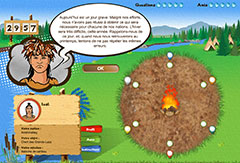 |
Message from the chief if you have failed | Today is a sad day. Despite our efforts, we have not succeeded in obtaining what was needed for each of our nations. We will have a hard winter, this year. Let us remember this day, and, when we meet again in the spring, let us try not to make the same mistakes. | Main page showing the Wendat chief sad. |
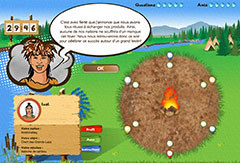 |
Message from the chief if you have succeeded | I am proud to announce to you that we have all succeeded in trading our items. None of our nations will lack what it needs this winter. We are gathered here this evening to celebrate this success with a great feast! | Main page showing the Wendat chief happy. |
